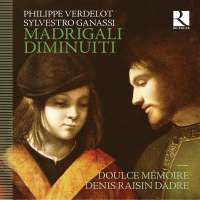Texte paru dans: / Appeared in: |
|
|
Outil de traduction ~ (Très approximatif) |
|
|
Reviewer: Barry
Brenesal While the bulk of this release is devoted to a selection of the madrigals and songs of Philippe Verdelot (c. 1480–c. 1530), its secondary purpose is to display the techniques for recorder variation and ornamentation—diminuiti e pasaggi—that the composer’s slightly younger contemporary, the musician Silvestro Ganassi, explained in his 1535 treatise Opera initulata Fontegara. This lends the album an intriguing double focus, first, because Verdelot’s dignified, rhapsodic art is seldom explored in depth on disc, and second, because it is rare to observe an early music ensemble perform several works twice, once without variation and once with. There are four examples of that included on this release, five if you count (as I do) the anonymous La Ternarina as a variant of Verdelot’s Ardenti miei sospiri, plus one piece offered in three variants: Verdelot’s Madonna qual certezza, arranged for solo voice with instrumental accompaniment, for instrumental ensemble, and in an intabulation for lute by Melchior de Barberis. The final cut on the disc, an anonymous work, Pacienta ognom mi dice, combines both approaches, with the soprano singing all but the final line of the first three verses, followed by the recorder performing a variant on the fourth, with the soprano returning for its final line and the fifth verse. And in the sung arrangement of In me cresce l’ardore, the recorder sometimes doubles the vocal line, and sometimes performs light arabesques around it. Everything is cleverly done, and indeed, Verdelot’s music, with its emphasis on chordal support of the top line, translates effectively into instrumental form.
I’m more than a bit confused at remarks in Dadre’s liner notes insisting that instrumental divisions and ornamentation should implement Baldassare Castiglione’s concept of sprezzatura. This he properly defines as “studied nonchalance,” never drawing attention to one’s technical skill. But Castiglione, who praises this highly this in his famous Book of the Courtier, recommends it only to his audience of young nobility, so as to differentiate them in any action—dancing, singing, painting, playing an instrument, engaging in any sport—from paid professionals, who will understandably draw attention to their talents. This would seem to point in the opposite direction from what Dadre intends, since he and his Doulce Mémoire ensemble are, after all, paid professionals; but it’s a point Dadre ignores. He backs up his position about not demonstrating great musical technique by pointing to Paolo Pino’s Dialogo de pittura and Lodovico Dolce’s Dialogo della pittura, which both suggest art should conceal art—except he neglects to mention that the subject of these works is painting, not music. Whether an argument applicable to one art is automatically appropriate for another is questionable; and in any case, neither author had music in mind.
That noted, I’ve no idea why Dadre chose to state this theory at some length and force, since there is no opportunity here to test it. Due to the solemnity of Verdelot’s music and its usual measured gait, any application of fast divisions to demonstrate technical expertise would seem frivolous, and break on most occasions his expressive sobriety. But in the one piece here whose text pushes the expressive framework to extremes—Madonna qual certezza, with its mention of intense passion driving the speaker to burning and freezing—Dadre does let his technique loose to a greater extent. It’s all rather puzzling.
The instrumental performances are up to Doulce Mémoire’s usual technical standards, combining discipline, energy, and clarity through all the parts. I don’t find soprano Clara Coutouly quite as good here, though, as she was on the Ensemble Céladon’s Nuits Occitanes (Ricercar 340; Fanfare 38:2) a couple of years ago. Her pleasant voice sounds a bit strained the few times this music requires her to rise above her comfortable mid-range. Enunciation is less than moderate. Breathing in particular is an issue. Verdelot doesn’t test his performers’ ranges, but he does expect them to sing long flowing lines without interruption for a second breath or ending phrases with a weak, poorly unsupported sound—both of which do occur regularly on this album.
On balance,
I’d still recommend this release. The music is rarely heard, and Verdelot’s
ruminative eloquence, though repetitive in the long term, works especially
well when the textures are as pleasantly varied as they are here. But given
the problems I have with Coutouly, I would suggest you try before you buy.
| |
|
Support us financially by purchasing this disc from eiher one of these suppliers. Un achat via l'un ou l'autre des fournisseurs proposés contribue à défrayer les coûts d'exploitation de ce site. |
|
|
|
|
|
Cliquez l'un ou l'autre
bouton pour découvrir bien d'autres critiques de CD |
|




